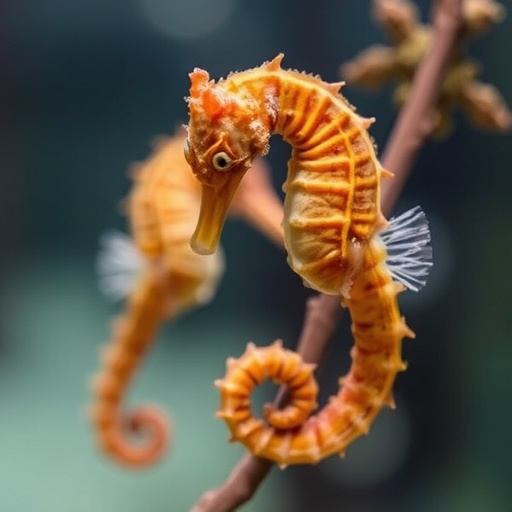In an unprecedented scope, authorities have intercepted close to five million smuggled seahorses over the past decade, a figure that underscores an alarming scale of illegal wildlife trade far exceeding prior estimations. Valued at approximately CAD$29 million, these seizures reveal not only the magnitude of illicit marine trafficking but also the complex global network that facilitates the movement of such species, often hidden in plain sight within passenger luggage or sea cargo.
This revelation emerges from a comprehensive analysis published in Conservation Biology, where researchers meticulously compiled online seizure reports spanning from 2010 to 2021. Their data implicates 62 countries in the seahorse smuggling network, highlighting the vast geographic spread and international character of the trade. Dried seahorses, prized in traditional medicine markets predominantly in Asia, have become commodities transported relentlessly across continents, posing a formidable challenge for conservationists and law enforcement agencies alike.
Dr. Sarah Foster, a research associate at the University of British Columbia’s Project Seahorse and an authority on the subject within the International Union for Conservation of Nature (IUCN) global expert group, emphasized that their seizure dataset—comprising nearly 300 incidents—represents merely the visible fraction of a far larger illegal trade. She notes that reliance on voluntary online disclosures and government reports likely underestimates the true extent, suggesting that the black market for seahorses operates with substantial opacity and impunity.
Notably, these smuggled seahorses rarely appear alone; they are frequently discovered alongside other trafficked wildlife such as elephant ivory and pangolin scales. This intersection between marine and terrestrial wildlife crime elucidates how smuggling syndicates leverage expansive, interconnected global networks to sustain various illicit trades. These findings hint at sophisticated logistical operations capable of circumventing regulatory scrutiny across different regulatory domains and transport modalities.
The study also reveals emerging trade routes linking Europe and Latin America with traditional importers like China and Hong Kong. This diversification of trafficking paths suggests an adaptive criminal network that responds dynamically to enforcement pressures and market demands. The continuous evolution of these routes necessitates equally agile and well-resourced enforcement strategies, provoking calls from experts for international cooperation and strengthened detection capabilities.
Legal international trade in seahorses does exist under the auspices of the Convention on International Trade in Endangered Species of Wild Fauna and Flora (CITES). This treaty, which binds 184 countries, mandates permits assuring that traded specimens do not threaten wild populations. However, bureaucratic hurdles and the difficulty in proving sustainability often dissuade legal trade, inadvertently pushing commerce underground. This paradox challenges governments and conservation bodies to streamline certification processes while safeguarding ecosystem health.
Moreover, the scarcity of reliable seizure data specifically addressing marine wildlife hampers informed policy interventions. Enforcement agencies have historically concentrated on more prominent terrestrial species with high-profile charisma like elephants or tigers, resulting in a relative neglect of oceanic species vulnerable to overexploitation. Such bias not only limits resource allocation but also fails to capture the full ecological and economic significance of crimes involving marine fauna.
The senior author of the study, Dr. Teale Phelps Bondaroff of OceansAsia, advocates for a dual strategy to combat the illegal seahorse trade. He stresses the necessity of deploying rigorous investigative methods, enhancing enforcement diligence, and instituting meaningful legal penalties to disrupt trafficking pipelines effectively. Simultaneously, he underscores the power of innovative research tools—such as online monitoring and forensic technologies—to trace covert operations and preempt illicit flows before they escalate.
Findings show that the majority of seizures transpire at transit hubs or destination points, pinpointing critical choke points for intervention. Airports emerge as key fronts where passenger baggage is a frequent vector for smuggled seahorses. Contrastingly, the most voluminous confiscations occur through sea cargo shipments, emphasizing the persistent challenge of maritime border control. This dichotomy underscores the urgent need for integrated surveillance across transportation modes.
Customs officials and law enforcement officers constitute the backbone of recorded seizures, yet frustratingly, only about seven percent of incidents include details about subsequent legal penalties. This information gap raises concerns about the prosecution and deterrence efficacy within current frameworks. Without transparent accountability, seizures risk becoming symbolic rather than substantive victories against wildlife crime.
Economic valuations based on records for 34 seizures estimate the average market price per seahorse at roughly CAD$7. When scaled to the entire dataset, this translates into a staggering cumulative value of CAD$29 million confiscated within a decade. Such figures reveal that seahorses are not trivial contraband but rather lucrative assets within illicit trade circuits that incentivize continued exploitation and criminal investment.
Recognizing the social dimension of the issue, Dr. Foster points out that seahorses sustain livelihoods for local fishers, making solutions complex. She advocates for interventions balancing enforcement with incentives, where sustainable and legal trade options are developed to encourage compliance without undercutting traditional income sources. This “carrot and stick” approach reflects a nuanced understanding of human and ecological interdependencies.
Finally, seahorses stand as potent marine biodiversity icons, embodying the intrinsic and cultural value of healthy ocean ecosystems. Engagement with traditional medicine practitioners, especially in markets like Hong Kong, reveals a shared sentiment: a desire for seahorses to endure indefinitely, recognizing their ecological and symbolic importance. Protecting these species, therefore, transcends mere conservation; it aligns with preserving cultural heritage and securing equitable benefits for stakeholders across the spectrum.
Subject of Research: Illegal Trade and Conservation of Seahorses
Article Title: Hidden Depths: The Global Scale of Seahorse Smuggling Revealed
News Publication Date: Not explicitly stated (study published “today” in Conservation Biology)
Web References: Conservation Biology Journal
References: DOI: 10.1111/cobi.70047
Keywords: Poaching, Fishing, Wildlife Management, Wildlife, Biodiversity Conservation, Conservation Policies, Fisheries Management, Animals, Aquatic Animals




